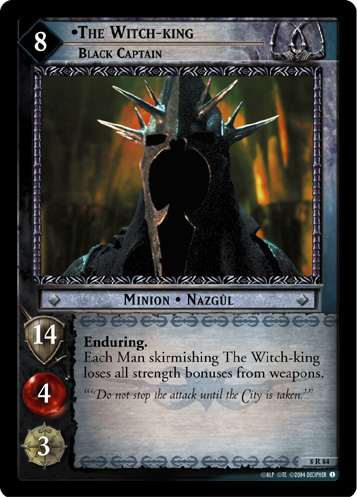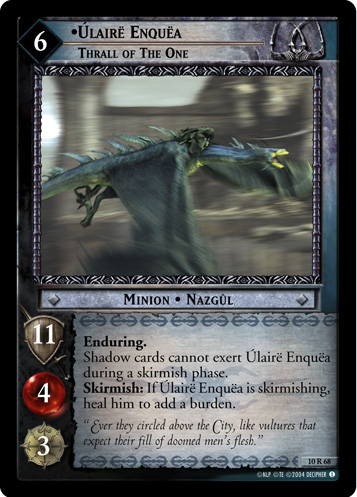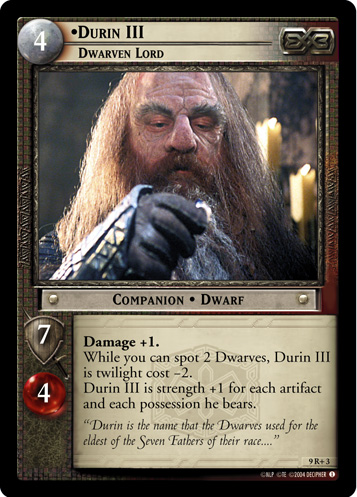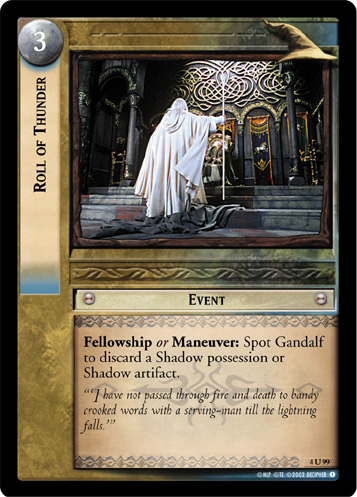Ring of Rancor (9R44)
Back to Reflections Index |
Horn of the Mark (9R45) |
Ring of Rancor (9R44) is a Ringwraith Artifact from the Reflections set.
| ||||||||||||||||||||
| ||||||||||||||||||||
| ||||||||||||||||||||
| ||||||||||||||||||||
Strategy[edit]
Ring of Rancor is one of several Ringwraith rings, first introduced in Reflections, and probably the most popular of them. Like those artifacts, it can return a Nazgul minion to your hand in the Regroup Phase, allowing you to replay that minion at a later site with all its wounds wiped, albeit at the cost of paying that minion's twilight cost again and having the card sit in your hand until then. That's a pretty strong effect on its own! However, Ring of Rancor is, on its face, the weakest of the rings that can be played on any Nazgûl: vitality doesn't help you kill companions, and healing Nazgûl with it is very expensive and a niche effect at best. Ring of Asperity (9R42)
 usually does a wound on its own, and helps its bearer do more wounds. So why is Ring of Rancor more popular? There are two answers, and they are both Ulaire Enquea.
usually does a wound on its own, and helps its bearer do more wounds. So why is Ring of Rancor more popular? There are two answers, and they are both Ulaire Enquea.
The first, and most common use is putting Ring of Rancor on an Enduring Nazgûl. King Block has The Witch-king, Black Captain (8R84)
 and a "Thrall of the One" version of each Nazgûl, like Úlairë Otsëa, Thrall of the One (8R81)
and a "Thrall of the One" version of each Nazgûl, like Úlairë Otsëa, Thrall of the One (8R81)
 . All of them have the Enduring keyword, giving them +2 strength for each wound on them. The Enduring Nazgûl deck is a beatdown/corruption deck that uses cards like Between Nazgûl and Prey (8R67)
. All of them have the Enduring keyword, giving them +2 strength for each wound on them. The Enduring Nazgûl deck is a beatdown/corruption deck that uses cards like Between Nazgûl and Prey (8R67)
 , Bent on Discovery (1R206)
, Bent on Discovery (1R206)
 , Ithil Stone (9R+47)
, Ithil Stone (9R+47)
 , Black Marshal (10U53)
, Black Marshal (10U53)
 , etc. to exert these minions, strengthening them while also generating useful effects. One more vitality means one more wound you can safely stack on a minion, turning into +2 strength. Where corruption comes into the picture is Úlairë Enquëa, Thrall of the One (10R68)
, etc. to exert these minions, strengthening them while also generating useful effects. One more vitality means one more wound you can safely stack on a minion, turning into +2 strength. Where corruption comes into the picture is Úlairë Enquëa, Thrall of the One (10R68)
 . If you stack wounds on Enquea TOTO, he can turn them into burdens during his skirmish. And those burdens can in turn turn into wounds on companions with Gates of the Dead City (3R81)
. If you stack wounds on Enquea TOTO, he can turn them into burdens during his skirmish. And those burdens can in turn turn into wounds on companions with Gates of the Dead City (3R81)
 . Ring of Rancor means you can stack up one more wound to convert to a burden, or that it takes one more wound on Enquea to kill him to prevent him from stacking those burdens. And since he heals himself, he probably survives to the end of the turn, so you can scoop him back into your hand with Ring of Rancor.
. Ring of Rancor means you can stack up one more wound to convert to a burden, or that it takes one more wound on Enquea to kill him to prevent him from stacking those burdens. And since he heals himself, he probably survives to the end of the turn, so you can scoop him back into your hand with Ring of Rancor.
The other Enquea, and a bit more of a niche use, is Úlairë Enquëa, Lieutenant of Morgul (1U231)
 . Shotgun Enquea wants to come down and kill a companion stone dead all at once. Normally, he can't finish off four-vitality companions like Aragorn, Gandalf, Durin III, Dwarven Lord (9R+3)
. Shotgun Enquea wants to come down and kill a companion stone dead all at once. Normally, he can't finish off four-vitality companions like Aragorn, Gandalf, Durin III, Dwarven Lord (9R+3)
 , Gil-galad, Elven High King (9R+15)
, Gil-galad, Elven High King (9R+15)
 , or most ents, unless they're already wounded. One more wound is likely the same result you'd get from Ring of Asperity (9R42)
, or most ents, unless they're already wounded. One more wound is likely the same result you'd get from Ring of Asperity (9R42)
 , which also lets you shotgun Aragorn or Gandalf all at once if they are unwounded and don't have any vitality boosters (which they often have). However, the rarely-useful healing on Ring of Rancor happens in the Maneuver Phase, the same phase when Shotgun Enquea is handing out wounds. So if your opponent has excess burdens stacked, you can turn those excess burdens into even more wounds. Be careful that you cause as many wounds as possible before reducing the size of the Fellowship below six or the burden stack below five, bringing the shotgun rampage to an end. This combo needs a lot of different moving parts to come together, but when it does, it can win the game outright.
, which also lets you shotgun Aragorn or Gandalf all at once if they are unwounded and don't have any vitality boosters (which they often have). However, the rarely-useful healing on Ring of Rancor happens in the Maneuver Phase, the same phase when Shotgun Enquea is handing out wounds. So if your opponent has excess burdens stacked, you can turn those excess burdens into even more wounds. Be careful that you cause as many wounds as possible before reducing the size of the Fellowship below six or the burden stack below five, bringing the shotgun rampage to an end. This combo needs a lot of different moving parts to come together, but when it does, it can win the game outright.
As long as you're playing Nazgûl, Ring of Rancor won't clog up your hand. It's free, and it's a fine play on any Nazgûl you're likely to want to play multiple times, like Úlairë Cantëa, Faster Than Winds (7R211)
 , Úlairë Nelya, Third of the Nine Riders (11S222)
, Úlairë Nelya, Third of the Nine Riders (11S222)
 , Úlairë Toldëa, Black Shadow (12U180)
, Úlairë Toldëa, Black Shadow (12U180)
 , or Úlairë Lemenya, Eternally Threatening (15R185)
, or Úlairë Lemenya, Eternally Threatening (15R185)
 . And, worst case, you can play it on any old ringwraith you want, just to get it out of your hand. You don't have to use its ability in the Regroup Phase if you don't want that Nazgûl minion back in your hand, or if you'd rather leave that minion in play to intimidate your opponent from trying to double move.
. And, worst case, you can play it on any old ringwraith you want, just to get it out of your hand. You don't have to use its ability in the Regroup Phase if you don't want that Nazgûl minion back in your hand, or if you'd rather leave that minion in play to intimidate your opponent from trying to double move.
Strengths and Weaknesses[edit]
Synergizes With...[edit]
- All Enduring Nazgul minions, but especially Úlairë Enquëa, Thrall of the One (10R68)

- Úlairë Enquëa, Lieutenant of Morgul (1U231)
 , both to do one more wound and as a possible alternate win condition in a corruption deck
, both to do one more wound and as a possible alternate win condition in a corruption deck
Strong Versus...[edit]
- This is chiefly a combo piece that doubles as a glue card for relevant Nazgûl decks. It doesn't do much harm to most Free Peoples strategies on its own, but rather makes powerful minions even better.
- It does make minions very slightly more resistant to direct wounding and archery.
Weak Versus...[edit]
- If your opponent kills the minion bearing this card, you won't get to return it to your hand.
- Effects that discard minions in the regroup phase, like Dervorin (7U88)
 , Blood Runs Chill (8R3)
, Blood Runs Chill (8R3)
 , Narrow Escape (10U111)
, Narrow Escape (10U111)
 , and Out of the High Airs (10R17)
, and Out of the High Airs (10R17)
 , can discard the minion with the ring before it gets a chance to return to your hand.
, can discard the minion with the ring before it gets a chance to return to your hand. - Roll of Thunder (4U99)
 is the only card that can discard Ring of Rancor. Playing Roll of Thunder after the Nazgûl bearing the ring is exhausted will kill it.
is the only card that can discard Ring of Rancor. Playing Roll of Thunder after the Nazgûl bearing the ring is exhausted will kill it.


